跨文化交际
跨文化交际理论-跨文化交际主要理论
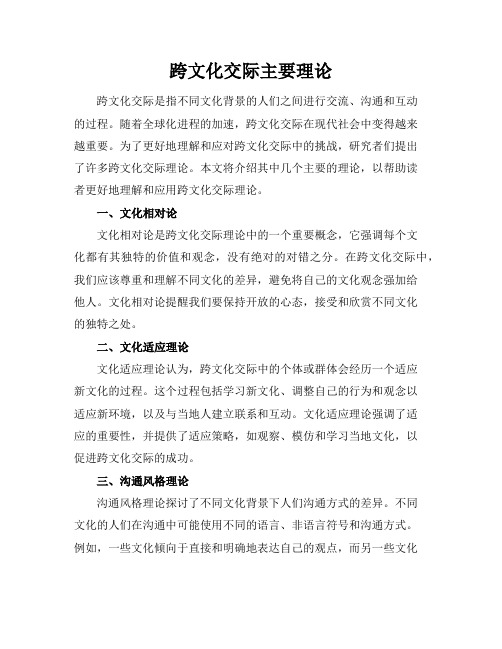
跨文化交际主要理论跨文化交际是指不同文化背景的人们之间进行交流、沟通和互动的过程。
随着全球化进程的加速,跨文化交际在现代社会中变得越来越重要。
为了更好地理解和应对跨文化交际中的挑战,研究者们提出了许多跨文化交际理论。
本文将介绍其中几个主要的理论,以帮助读者更好地理解和应用跨文化交际理论。
一、文化相对论文化相对论是跨文化交际理论中的一个重要概念,它强调每个文化都有其独特的价值和观念,没有绝对的对错之分。
在跨文化交际中,我们应该尊重和理解不同文化的差异,避免将自己的文化观念强加给他人。
文化相对论提醒我们要保持开放的心态,接受和欣赏不同文化的独特之处。
二、文化适应理论文化适应理论认为,跨文化交际中的个体或群体会经历一个适应新文化的过程。
这个过程包括学习新文化、调整自己的行为和观念以适应新环境,以及与当地人建立联系和互动。
文化适应理论强调了适应的重要性,并提供了适应策略,如观察、模仿和学习当地文化,以促进跨文化交际的成功。
三、沟通风格理论沟通风格理论探讨了不同文化背景下人们沟通方式的差异。
不同文化的人们在沟通中可能使用不同的语言、非语言符号和沟通方式。
例如,一些文化倾向于直接和明确地表达自己的观点,而另一些文化则更注重委婉和含蓄的表达。
了解不同文化的沟通风格,有助于我们更好地理解对方的意思,避免误解和冲突。
四、文化智力理论文化智力理论认为,跨文化交际中的成功取决于个体的文化智力水平。
文化智力是指个体对文化差异的意识和理解,以及在不同文化环境中有效沟通和适应的能力。
文化智力包括认知智力、情感智力和行为智力三个方面。
通过培养和提高自己的文化智力,我们可以更好地理解和应对跨文化交际中的挑战。
五、文化冲突理论文化冲突理论探讨了跨文化交际中可能出现的冲突和摩擦。
不同文化的人们在价值观、信仰、行为习惯等方面可能存在差异,这可能导致误解、偏见和冲突。
文化冲突理论提出了冲突解决策略,如建立共同目标、寻求共识、尊重差异和建立信任等,以促进跨文化交际的和谐与成功。
跨文化交际

什么是跨文化交际跨文化交际,即本族语者与非本族语者的交际,也指任何在语言和文化背景方面有差异的人们之间的交际。
本学期通过本门课程的学习,让我学会了一下三点:一、如何正确的审视不同文化之间的差异,二、如何提高跨文化适应能力,三、如何提高跨文化的交流技能。
随着中国对外开放程度的逐渐深入,西方社会的人和事物越来越多地走进了我们的视野,在这种情况下,跨国域、跨民族、跨文化的经济和社会交往将会与日俱增,这就为我们提供了许多与西方接触和交流的机会,这对于我们加深对的西方社会的理解是一件好事,但这却并不是一件简单的事情,因为我们所面对的是陌生的国家和文化,思维方式、生活习惯和行为方式与我们迥然不同的人,在与之交往的过程中不可避免的会出现文化冲突的现象,这时在跨文化交际课堂中学到的东西便起了大用!我总结了一下中西方的差异主要集中在以下几点:一、在客观主体方面,西方人向外探索客观世界,强调真善美、爱智,注重理性科学,注重求异,科学和逻辑发现。
中国人向内探索个人世界,强调真善美、崇善,注重情感、伦理,注重求同,经验、感情。
二、在处理问题方面,西方人采取不撞南墙不回头的态度,中国人采取不可中直取,只可曲终求的态度。
不同文化背景的人们在交际时,经常出现的一个现象就是套用自身所在社会的行为规范来判定对方行为的合理性,由于双方的行为规范存在差异,常常会产生误解、不快甚至更坏的结果。
比如说中国人轻拍小孩子的头部表示一种友好,而在西方国家,这是一种极不尊重小孩子的做法,父母会对此非常愤怒。
所以说在跨文化交际中是否能够正确地识别和运用行为规范是保证跨文化交际顺利进行的重要因素。
要保障跨文化交际的顺利进行,就必须理解对方的行为规范,尤其是什么行为是被禁止的,最好的办法就是遵循入乡随俗的原则。
三、在发表个人看法时,西方人直言、直去,中国人谨言、拐弯。
四、在民族性格方面,西方人偏重功利,好走极端,与其他民族存在斗争,强调以力争天下。
中国人偏重道义,以“中庸和谐”为贵,强调协和万邦。
跨文化交际知识点汇总
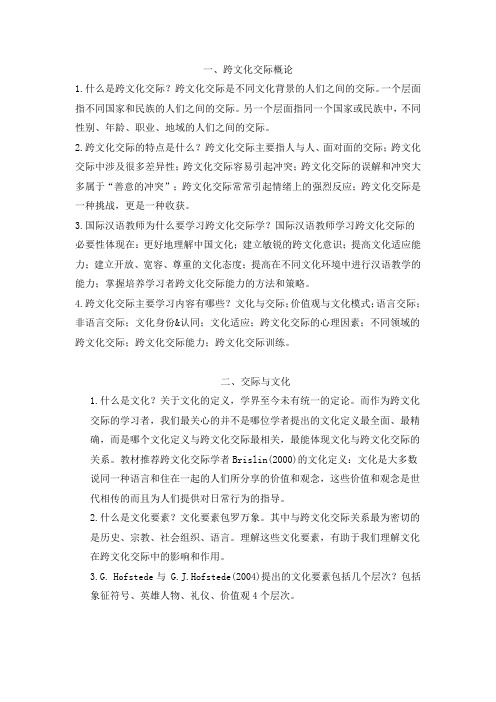
一、跨文化交际概论1.什么是跨文化交际?跨文化交际是不同文化背景的人们之间的交际。
一个层面指不同国家和民族的人们之间的交际。
另一个层面指同一个国家或民族中,不同性别、年龄、职业、地域的人们之间的交际。
2.跨文化交际的特点是什么?跨文化交际主要指人与人、面对面的交际;跨文化交际中涉及很多差异性;跨文化交际容易引起冲突;跨文化交际的误解和冲突大多属于“善意的冲突”;跨文化交际常常引起情绪上的强烈反应;跨文化交际是一种挑战,更是一种收获。
3.国际汉语教师为什么要学习跨文化交际学?国际汉语教师学习跨文化交际的必要性体现在:更好地理解中国文化;建立敏锐的跨文化意识;提高文化适应能力;建立开放、宽容、尊重的文化态度;提高在不同文化环境中进行汉语教学的能力;掌握培养学习者跨文化交际能力的方法和策略。
4.跨文化交际主要学习内容有哪些?文化与交际;价值观与文化模式;语言交际;非语言交际;文化身份&认同;文化适应;跨文化交际的心理因素;不同领域的跨文化交际;跨文化交际能力;跨文化交际训练。
二、交际与文化1.什么是文化?关于文化的定义,学界至今未有统一的定论。
而作为跨文化交际的学习者,我们最关心的并不是哪位学者提出的文化定义最全面、最精确,而是哪个文化定义与跨文化交际最相关,最能体现文化与跨文化交际的关系。
教材推荐跨文化交际学者Brislin(2000)的文化定义:文化是大多数说同一种语言和住在一起的人们所分享的价值和观念,这些价值和观念是世代相传的而且为人们提供对日常行为的指导。
2.什么是文化要素?文化要素包罗万象。
其中与跨文化交际关系最为密切的是历史、宗教、社会组织、语言。
理解这些文化要素,有助于我们理解文化在跨文化交际中的影响和作用。
3.G. Hofstede与 G.J.Hofstede(2004)提出的文化要素包括几个层次?包括象征符号、英雄人物、礼仪、价值观4个层次。
4.在跨文化交际领域,常用的文化分类方法有几种?分别是什么?有两种文化分类的方法在跨文化交际领域最为常用。
跨文化交际理论

跨文化交际理论一.文化、交际、跨文化交际:1.“文化”的含义:①“文化”二字最初没有联系在一起,它的意思是统治者通过观察天象,可以了解时序的变化,通过观察人类社会的各种现象,可以用教育感化的手段来治理天下。
②西方的“文化”引申出对人的性情的陶冶和品德的培养,泰勒认为,“文化”是包括知识、信仰、艺术、道德、法律、习俗和任何人作为一名社会成员而获得的能力和习惯在内的复杂整理。
③马克思主义理论家认为文化分为两种:狭义的文化指的是历史上一定的物质资料生产方式的基础上产生和发展的社会精神生活形式的总和;广义的文化指的是人类在社会历史实践过程中所创造的物质财富和精神财富的总和。
2.文化的分类:按内容分包括:物质文化、行为文化、制度文化、观念文化四个方面。
3.文化的特性:(1)文化史人类独有的,是区别人类和动物的主要标志,文化史社会遗产,而不是生理遗传。
(2)文化不是先天就有的,而是后天习得的。
(3)文化中的大部分是不自觉的,人总是自然而然地表现其文化色彩的。
(4)文化是人们行动的指南。
(5)文化是动态的,文化的形态与一定的历史时期相联系。
4.隐性文化的基本内容:包括以下内容:时间观念,对空间的利用,成就感,交际模式,对环境的取向,家庭关系,上下级关系模式,对个人的看法,对竞争和合作的偏爱,谦虚的挂念,对规章制度的需要,对宇宙的看法,法律的观念,工作积极性,对领导的看法,社交频率,友谊的性质,控制感情的模式,依据年龄、性别、阶级、职业、亲属的关系,确定地位及相关角色。
5.语言和文化的关系:①语言文化的重要组成部分,语言与文化是部分与整体的关系:一种文化不可能没有与之相应的语言;抽取文化内容,语言也不能独立存在。
②语言是用于记录文化的符号体系,是文化的主要载体。
③语言和文化相互依附、促进和制约。
6.人类交际的主要手段:符号是人们交际时使用的主要手段,任何符号都可以用来交际。
7.组成交际行为的八个重要因素:①信息源/行为源②编码③信息④渠道⑤信息接收者/反应者⑥译码⑦反应⑧反馈8.影响交际的因素:①宽泛的交际环境:包括价值观念,文化取向,宇宙观,社会结构,心理因素,物理环境因素等。
跨文化交际论文(3篇)

跨文化交际论文(3篇)一、关于跨文化交际的重要性随着社会的发展,全球经济一体化的形成,我国人民对于教学方式和教学内容有了新的期许,在现代社会中,想要获得成功,就需要具备良好的交际表现能力。
在跨文化的语境中所认为成功的交际是能够带来发展机会、财富以及和平的;失败的交际会使得敌对局面、偏见以及冲突产生。
在科技水平的迅猛发展中,我们正在经历的社会形势是多种多样的,如:信息化、全球化以及网络化等,不断地丰富着我们的生活。
不同文化背景的人们相互交际是一个复杂的过程,在讲外语和理解外语时都应该遵循该外语的语用规律及文化规则。
对于法语的口语教学而言,这也是一种跨文化交流的行为,语言的不同使得其表达的意识也会有差异,在法语中时常使用到的词汇用汉语解释意境就可能很大不同。
如:在法语中有着非常丰富的代词,代词用法比较复杂,因而学生在没有熟练掌握的情况下,使用法语代词会变得非常困难。
针对于您(vous)和你(tu)在法语中的用法,我们在课堂或者课后的练习中已经习惯了使用tu,随后在一些非常正式的场合也会将tu脱口而出,显然这意味着交际错误出现了。
另外,与tu所对应的动词有着简单的变位,因而学生更加喜欢在表达上使用到tu,长时间下来他们容易将语言场合忽视掉,这样错误语域的选择是外语学习中的大忌。
因此,我们需要十分的重视对学生这方面的教育,逐步将跨文化交际教学的能力加强,尽可能的将错误语境的现象减少。
如:中国自古有“爱屋及乌”的说法,法国也有着Qui m'aime,aime mon chien的说法,翻译过来就是“爱屋及狗”。
可见,中法两国巨大的文化差异,也体现在人们对于宠物的不同态度,若是学生没能够很好的掌握到、认识到这一点,就很容易发生语境错误,对于跨文化的交流非常不利。
二、培养学生跨文化法语口语交际的能力根据著名学者Gudykunst的理论,有效的跨文化交际能力应该包括基本交际能力系统、情感和关系能力系统、情节能力系统和交际方略能力系统。
跨文化交际
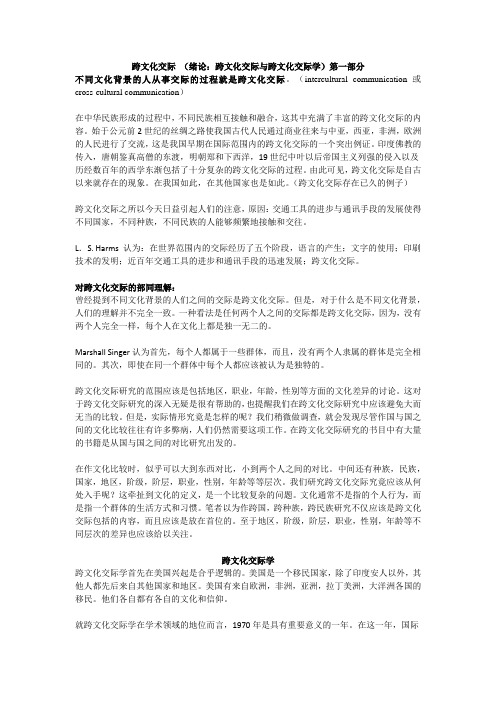
跨文化交际(绪论:跨文化交际与跨文化交际学)第一部分不同文化背景的人从事交际的过程就是跨文化交际。
(intercultural communication或cross-cultural communication)在中华民族形成的过程中,不同民族相互接触和融合,这其中充满了丰富的跨文化交际的内容。
始于公元前2世纪的丝绸之路使我国古代人民通过商业往来与中亚,西亚,非洲,欧洲的人民进行了交流,这是我国早期在国际范围内的跨文化交际的一个突出例证。
印度佛教的传入,唐朝鉴真高僧的东渡,明朝郑和下西洋,19世纪中叶以后帝国主义列强的侵入以及历经数百年的西学东渐包括了十分复杂的跨文化交际的过程。
由此可见,跨文化交际是自古以来就存在的现象。
在我国如此,在其他国家也是如此。
(跨文化交际存在已久的例子)跨文化交际之所以今天日益引起人们的注意,原因:交通工具的进步与通讯手段的发展使得不同国家,不同种族,不同民族的人能够频繁地接触和交往。
L.S. Harms 认为:在世界范围内的交际经历了五个阶段,语言的产生;文字的使用;印刷技术的发明;近百年交通工具的进步和通讯手段的迅速发展;跨文化交际。
对跨文化交际的部同理解:曾经提到不同文化背景的人们之间的交际是跨文化交际。
但是,对于什么是不同文化背景,人们的理解并不完全一致。
一种看法是任何两个人之间的交际都是跨文化交际,因为,没有两个人完全一样,每个人在文化上都是独一无二的。
Marshall Singer认为首先,每个人都属于一些群体,而且,没有两个人隶属的群体是完全相同的。
其次,即使在同一个群体中每个人都应该被认为是独特的。
跨文化交际研究的范围应该是包括地区,职业,年龄,性别等方面的文化差异的讨论。
这对于跨文化交际研究的深入无疑是很有帮助的,也提醒我们在跨文化交际研究中应该避免大而无当的比较。
但是,实际情形究竟是怎样的呢?我们稍微做调查,就会发现尽管作国与国之间的文化比较往往有许多弊病,人们仍然需要这项工作。
跨文化交际 知识点整理
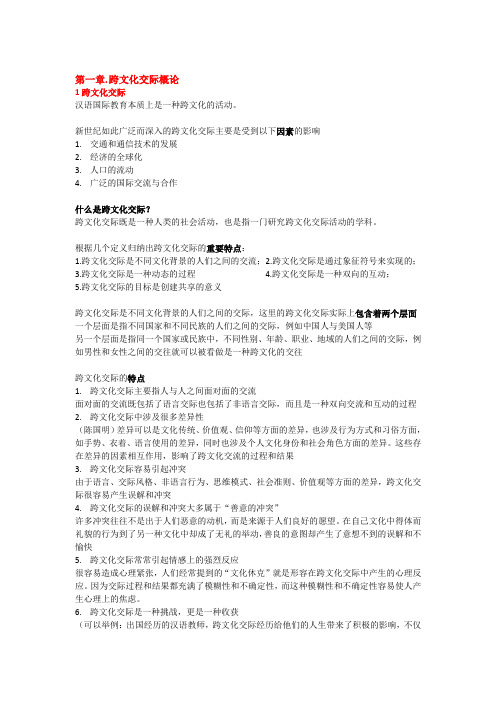
第一章.跨文化交际概论1跨文化交际汉语国际教育本质上是一种跨文化的活动。
新世纪如此广泛而深入的跨文化交际主要是受到以下因素的影响1.交通和通信技术的发展2.经济的全球化3.人口的流动4.广泛的国际交流与合作什么是跨文化交际?跨文化交际既是一种人类的社会活动,也是指一门研究跨文化交际活动的学科。
根据几个定义归纳出跨文化交际的重要特点:1.跨文化交际是不同文化背景的人们之间的交流;2.跨文化交际是通过象征符号来实现的;3.跨文化交际是一种动态的过程4.跨文化交际是一种双向的互动;5.跨文化交际的目标是创建共享的意义跨文化交际是不同文化背景的人们之间的交际,这里的跨文化交际实际上包含着两个层面一个层面是指不同国家和不同民族的人们之间的交际,例如中国人与美国人等另一个层面是指同一个国家或民族中,不同性别、年龄、职业、地域的人们之间的交际,例如男性和女性之间的交往就可以被看做是一种跨文化的交往跨文化交际的特点1.跨文化交际主要指人与人之间面对面的交流面对面的交流既包括了语言交际也包括了非语言交际,而且是一种双向交流和互动的过程2.跨文化交际中涉及很多差异性(陈国明)差异可以是文化传统、价值观、信仰等方面的差异,也涉及行为方式和习俗方面,如手势、衣着、语言使用的差异,同时也涉及个人文化身份和社会角色方面的差异。
这些存在差异的因素相互作用,影响了跨文化交流的过程和结果3.跨文化交际容易引起冲突由于语言、交际风格、非语言行为、思维模式、社会准则、价值观等方面的差异,跨文化交际很容易产生误解和冲突4.跨文化交际的误解和冲突大多属于“善意的冲突”许多冲突往往不是出于人们恶意的动机,而是来源于人们良好的愿望。
在自己文化中得体而礼貌的行为到了另一种文化中却成了无礼的举动,善良的意图却产生了意想不到的误解和不愉快5.跨文化交际常常引起情感上的强烈反应很容易造成心理紧张,人们经常提到的“文化休克”就是形容在跨文化交际中产生的心理反应。
跨文化交际心得(精品5篇)
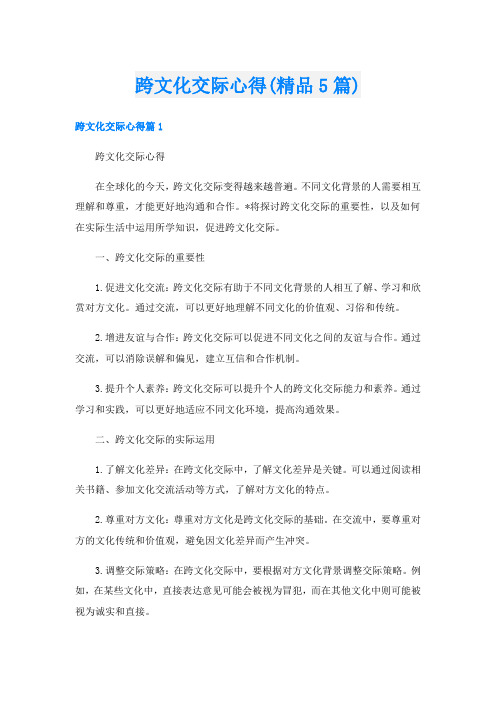
跨文化交际心得(精品5篇)跨文化交际心得篇1跨文化交际心得在全球化的今天,跨文化交际变得越来越普遍。
不同文化背景的人需要相互理解和尊重,才能更好地沟通和合作。
*将探讨跨文化交际的重要性,以及如何在实际生活中运用所学知识,促进跨文化交际。
一、跨文化交际的重要性1.促进文化交流:跨文化交际有助于不同文化背景的人相互了解、学习和欣赏对方文化。
通过交流,可以更好地理解不同文化的价值观、习俗和传统。
2.增进友谊与合作:跨文化交际可以促进不同文化之间的友谊与合作。
通过交流,可以消除误解和偏见,建立互信和合作机制。
3.提升个人素养:跨文化交际可以提升个人的跨文化交际能力和素养。
通过学习和实践,可以更好地适应不同文化环境,提高沟通效果。
二、跨文化交际的实际运用1.了解文化差异:在跨文化交际中,了解文化差异是关键。
可以通过阅读相关书籍、参加文化交流活动等方式,了解对方文化的特点。
2.尊重对方文化:尊重对方文化是跨文化交际的基础。
在交流中,要尊重对方的文化传统和价值观,避免因文化差异而产生冲突。
3.调整交际策略:在跨文化交际中,要根据对方文化背景调整交际策略。
例如,在某些文化中,直接表达意见可能会被视为冒犯,而在其他文化中则可能被视为诚实和直接。
4.练习口语表达:在跨文化交际中,口语表达是关键。
要积极练习口语表达,提高口语能力,以便更好地与不同文化背景的人交流。
总之,跨文化交际是全球化时代的必然趋势。
要积极学习跨文化交际知识,并在实际生活中运用所学知识,促进跨文化交际。
跨文化交际心得篇2跨文化交际是一种涉及不同文化背景的交际活动,需要参与者具备跨文化知识和交际技巧。
近年来,随着全球化的不断发展,跨文化交际变得越来越普遍,也越来越重要。
*将探讨跨文化交际的重要性、过程和收获,并反思自己在跨文化交际中的问题和不足。
跨文化交际的重要性在于,不同文化之间的差异可能导致误解和冲突。
通过跨文化交际,我们可以更好地了解和尊重不同文化背景的人,促进文化交流和理解。
跨文化交际
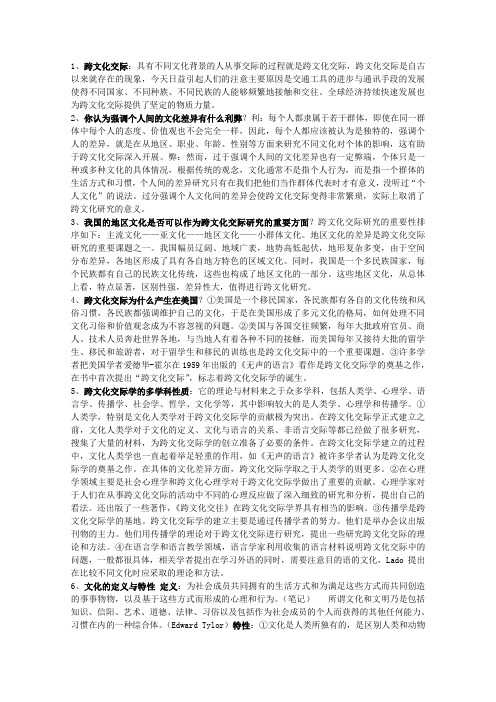
1、跨文化交际:具有不同文化背景的人从事交际的过程就是跨文化交际,跨文化交际是自古以来就存在的现象,今天日益引起人们的注意主要原因是交通工具的进步与通讯手段的发展使得不同国家、不同种族、不同民族的人能够频繁地接触和交往。
全球经济持续快速发展也为跨文化交际提供了坚定的物质力量。
2、你认为强调个人间的文化差异有什么利弊?利:每个人都隶属于若干群体,即使在同一群体中每个人的态度、价值观也不会完全一样,因此,每个人都应该被认为是独特的,强调个人的差异,就是在从地区、职业、年龄、性别等方面来研究不同文化对个体的影响,这有助于跨文化交际深入开展。
弊:然而,过于强调个人间的文化差异也有一定弊端,个体只是一种或多种文化的具体情况,根据传统的观念,文化通常不是指个人行为,而是指一个群体的生活方式和习惯,个人间的差异研究只有在我们把他们当作群体代表时才有意义,没听过“个人文化”的说法。
过分强调个人文化间的差异会使跨文化交际变得非常繁琐,实际上取消了跨文化研究的意义。
3、我国的地区文化是否可以作为跨文化交际研究的重要方面?跨文化交际研究的重要性排序如下:主流文化——亚文化——地区文化——小群体文化。
地区文化的差异是跨文化交际研究的重要课题之一。
我国幅员辽阔、地域广袤,地势高低起伏,地形复杂多变,由于空间分布差异,各地区形成了具有各自地方特色的区域文化。
同时,我国是一个多民族国家,每个民族都有自己的民族文化传统,这些也构成了地区文化的一部分。
这些地区文化,从总体上看,特点显著,区别性强,差异性大,值得进行跨文化研究。
4、跨文化交际为什么产生在美国?①美国是一个移民国家,各民族都有各自的文化传统和风俗习惯,各民族都强调维护自己的文化,于是在美国形成了多元文化的格局,如何处理不同文化习俗和价值观念成为不容忽视的问题。
②美国与各国交往频繁,每年大批政府官员、商人、技术人员奔赴世界各地,与当地人有着各种不同的接触,而美国每年又接待大批的留学生、移民和旅游者,对于留学生和移民的训练也是跨文化交际中的一个重要课题。
跨文化交际学概论

跨文化交际学概论胡文仲第一部分绪论:跨文化交际和跨文化交际学第一章跨文化交际一、什么是跨文化交际●不同文化背景的人从事交际的过程就是跨文化交际,如直接和外国人接触,阅读外国小说,看外国电影等。
●跨文化交际是自古以来就有的现象,如我国汉朝的丝绸之路、佛教的传入、郑和下西洋。
●L。
S。
Harms认为:世界范围内的交际经历了五个阶段:①语言的产生②文字的使用③印刷术的发明④近百年交通工具的进步和通讯手段的发展⑤跨文化交际。
二、对跨文化交际的不同理解●Marshall Singer认为:①每个人隶属于若干群体,没有两个人隶属的群体是完全相同的;②即使在同一群体,每个人的态度、价值、信念也会完全不同;因此,每个人都是独特的,从严格意义上讲,任何人与人之间的交际都应该被视为跨文化交际。
●这种观点提醒我们应该避免空泛的比较,但是,在跨文化交际研究中应该首先把眼光集中于国别研究,集中于一个国家中的主流文化的研究。
第二章跨文化交际学●跨文化交际的英文:Intercultural Communication●跨文化交际学首先在美国兴起。
●许多学者把Eward Hall在1959年出版的《无声的语言》(The Silent Language)看作是跨文化交际学的奠基之作。
●1970年国际传播学会成人跨文化交际学是传播学的一个分支,在学会下面成立了跨文化交际学分会。
●1972年,第一届跨文化交际学国际会议在日本东京举行。
●1974年,跨文化教育训练与研究学会(SIETAR)在美国成立,后改名为国际跨文化教育训练与研究学会。
●跨文化交际学在我国大致是从80年代初期开始的。
●跨文化交际学一个突出的特点是它的多学科性质,其中影响较大的是人类学、心理学、传播学.人类学家的跨文化交际学著作:● A.L.Kroeber和Clyde Kluckhohn合著的《文化概念与定义评述》是论述文化定义的经典之作。
●Ruth Benedict的《菊与剑》对日本文化的模式做了深入的分析;许烺光的《美国人与中国人——通向分歧之路》对于中美文化的差异做了十分全面而透辟的分析.心理学家的跨文化交际学著作:●Richard Brislin《跨文化交往》●Geert Hofstede的《文化的后果》、《文化与组织——心灵软件》●正是由于跨文化交际的多学科性质,它没有一套一成不变的理论和研究方法。
跨文化交际——精选推荐
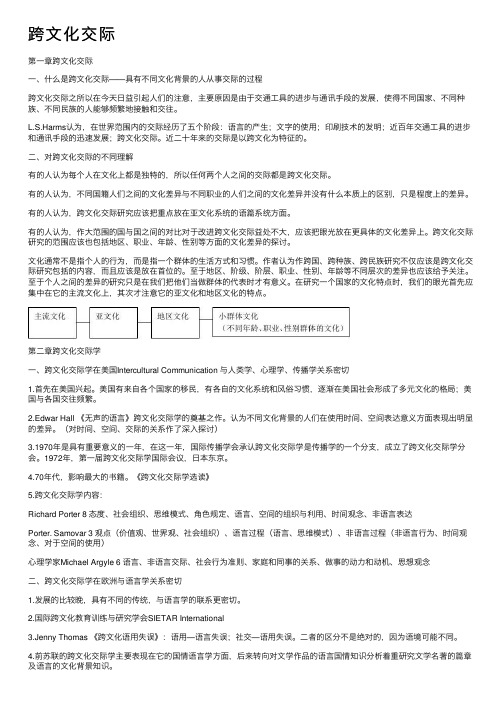
跨⽂化交际第⼀章跨⽂化交际⼀、什么是跨⽂化交际——具有不同⽂化背景的⼈从事交际的过程跨⽂化交际之所以在今天⽇益引起⼈们的注意,主要原因是由于交通⼯具的进步与通讯⼿段的发展,使得不同国家、不同种族、不同民族的⼈能够频繁地接触和交往。
L.S.Harms认为,在世界范围内的交际经历了五个阶段:语⾔的产⽣;⽂字的使⽤;印刷技术的发明;近百年交通⼯具的进步和通讯⼿段的迅速发展;跨⽂化交际。
近⼆⼗年来的交际是以跨⽂化为特征的。
⼆、对跨⽂化交际的不同理解有的⼈认为每个⼈在⽂化上都是独特的,所以任何两个⼈之间的交际都是跨⽂化交际。
有的⼈认为,不同国籍⼈们之间的⽂化差异与不同职业的⼈们之间的⽂化差异并没有什么本质上的区别,只是程度上的差异。
有的⼈认为,跨⽂化交际研究应该把重点放在亚⽂化系统的语篇系统⽅⾯。
有的⼈认为,作⼤范围的国与国之间的对⽐对于改进跨⽂化交际益处不⼤,应该把眼光放在更具体的⽂化差异上。
跨⽂化交际研究的范围应该也包括地区、职业、年龄、性别等⽅⾯的⽂化差异的探讨。
⽂化通常不是指个⼈的⾏为,⽽是指⼀个群体的⽣活⽅式和习惯。
作者认为作跨国、跨种族、跨民族研究不仅应该是跨⽂化交际研究包括的内容,⽽且应该是放在⾸位的。
⾄于地区、阶级、阶层、职业、性别、年龄等不同层次的差异也应该给予关注。
⾄于个⼈之间的差异的研究只是在我们把他们当做群体的代表时才有意义。
在研究⼀个国家的⽂化特点时,我们的眼光⾸先应集中在它的主流⽂化上,其次才注意它的亚⽂化和地区⽂化的特点。
第⼆章跨⽂化交际学⼀、跨⽂化交际学在美国Intercultural Communication 与⼈类学、⼼理学、传播学关系密切1.⾸先在美国兴起。
美国有来⾃各个国家的移民,有各⾃的⽂化系统和风俗习惯,逐渐在美国社会形成了多元⽂化的格局;美国与各国交往频繁。
2.Edwar Hall 《⽆声的语⾔》跨⽂化交际学的奠基之作。
认为不同⽂化背景的⼈们在使⽤时间、空间表达意义⽅⾯表现出明显的差异。
跨文化交际

名词解释1.跨文化交际①所谓跨文化交际,即指不同文化背景的人们之间的交际。
也就是说,所谓跨文化交际,实际上是包含了许多不同的维面,如跨种族交际、跨民族交际、同一主流文化内不同群体之间的交际、国际性的跨文化交际等等。
②在特定的交际情景中,具有不同的文化背景的交际者使用同一种语言(母语或者目的语)进行的口语交际。
这个概念界定是明确的,它是立足于对外汉语专业的需要而定的,于是与普通的跨文化交际概念是有区别的。
③跨文化交际的学科背景包括文化语言学, 社会语言学,言语交际学.④跨文化交际对于有些人来似乎说是一个新词,可实际上,我们时常在从事跨文化交际,只是我们不自觉而已。
例如:我们给外国游客指路、和留学生交往、阅读外国小说、看外国电影电视等等,都是不同形式的跨文化交际。
2.文化定势世界上大多数社会中都可能存在着若干群体或者社团,这些群体或者社团对地域、历史、生活方式以及价值观等方面的共享,使其成员形成、发展并强化了自己独特的文化及与之相适应的交际文化。
在跨文化交际研究中,学者们往往倾向于把某一文化群体的每一个成员都视为该文化定势的代表或者整体文化形象。
这种整体式的文化取向通常被称为文化定势。
3.价值观①在跨文化交际研究中,价值观是个至关重要的问题。
价值观是文化的底层,不理解其差异就不能理解不同文化之间的根本差异。
②价值观对人类的活动起着规定性或者指令性的作用,是人们行为的规则、思维的方式、认知的准绳、处世的哲学、推理的模式、评价的依据、道德的标准。
人们在不知不觉中通过交际习得这套价值系统,它变成为了他们的集体无意识,变成为了他们的信仰、心态、行为、生活等诸方面的可评价系统,变成为了他们民族性格的基石。
每一种文化都有其独特的一套系统,而价值观是它的核心。
③价值观总是相对稳定的,一个人的价值观是从出生开始,在家庭和社会的影响下逐步形成的。
一个人所处的社会生产方式及其所处的经济地位,对其价值观的形成有决定性的影响;同时舆论宣传,以及父母、老师、朋友和公众名人的观点与行为,对一个人的价值观形成也有不可忽视的作用4.体态语体态语( body language )是非语言交际的重要组成部份,它包括眼神、手势、身势、面部表情、体距、体触等。
跨文化交际知识点汇总

一、跨文化交际概论1.什么是跨文化交际?跨文化交际是不同文化背景的人们之间的交际。
一个层面指不同国家和民族的人们之间的交际。
另一个层面指同一个国家或民族中,不同性别、年龄、职业、地域的人们之间的交际。
2.跨文化交际的特点是什么?跨文化交际主要指人与人、面对面的交际;跨文化交际中涉及很多差异性;跨文化交际容易引起冲突;跨文化交际的误解和冲突大多属于“善意的冲突”;跨文化交际常常引起情绪上的强烈反应;跨文化交际是一种挑战,更是一种收获。
3.国际汉语教师为什么要学习跨文化交际学?国际汉语教师学习跨文化交际的必要性体现在:更好地理解中国文化;建立敏锐的跨文化意识;提高文化适应能力;建立开放、宽容、尊重的文化态度;提高在不同文化环境中进行汉语教学的能力;掌握培养学习者跨文化交际能力的方法和策略。
4.跨文化交际主要学习内容有哪些?文化与交际;价值观与文化模式;语言交际;非语言交际;文化身份&认同;文化适应;跨文化交际的心理因素;不同领域的跨文化交际;跨文化交际能力;跨文化交际训练。
二、交际与文化1.什么是文化?关于文化的定义,学界至今未有统一的定论。
而作为跨文化交际的学习者,我们最关心的并不是哪位学者提出的文化定义最全面、最精确,而是哪个文化定义与跨文化交际最相关,最能体现文化与跨文化交际的关系。
教材推荐跨文化交际学者Brislin(2000)的文化定义:文化是大多数说同一种语言和住在一起的人们所分享的价值和观念,这些价值和观念是世代相传的而且为人们提供对日常行为的指导。
2.什么是文化要素?文化要素包罗万象。
其中与跨文化交际关系最为密切的是历史、宗教、社会组织、语言。
理解这些文化要素,有助于我们理解文化在跨文化交际中的影响和作用。
3.G. Hofstede与 G.J.Hofstede(2004)提出的文化要素包括几个层次?包括象征符号、英雄人物、礼仪、价值观4个层次。
4.在跨文化交际领域,常用的文化分类方法有几种?分别是什么?有两种文化分类的方法在跨文化交际领域最为常用。
(完整版)跨文化交际
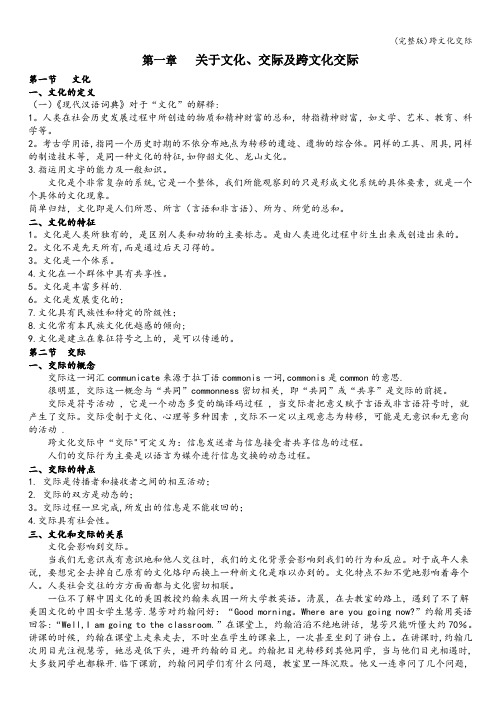
第一章关于文化、交际及跨文化交际第一节文化一、文化的定义(一)《现代汉语词典》对于“文化”的解释:1。
人类在社会历史发展过程中所创造的物质和精神财富的总和,特指精神财富,如文学、艺术、教育、科学等。
2。
考古学用语,指同一个历史时期的不依分布地点为转移的遗迹、遗物的综合体。
同样的工具、用具,同样的制造技术等,是同一种文化的特征,如仰韶文化、龙山文化。
3.指运用文字的能力及一般知识。
文化是个非常复杂的系统,它是一个整体,我们所能观察到的只是形成文化系统的具体要素,就是一个个具体的文化现象。
简单归结,文化即是人们所思、所言(言语和非言语)、所为、所觉的总和。
二、文化的特征1。
文化是人类所独有的,是区别人类和动物的主要标志。
是由人类进化过程中衍生出来或创造出来的。
2。
文化不是先天所有,而是通过后天习得的。
3。
文化是一个体系。
4.文化在一个群体中具有共享性。
5。
文化是丰富多样的.6。
文化是发展变化的;7.文化具有民族性和特定的阶级性;8.文化常有本民族文化优越感的倾向;9.文化是建立在象征符号之上的,是可以传递的。
第二节交际一、交际的概念交际这一词汇communicate来源于拉丁语commonis一词,commonis是common的意思.很明显,交际这一概念与“共同”commonness密切相关,即“共同”或“共享”是交际的前提。
交际是符号活动,它是一个动态多变的编译码过程,当交际者把意义赋予言语或非言语符号时,就产生了交际。
交际受制于文化、心理等多种因素 ,交际不一定以主观意志为转移,可能是无意识和无意向的活动 .跨文化交际中“交际"可定义为:信息发送者与信息接受者共享信息的过程。
人们的交际行为主要是以语言为媒介进行信息交换的动态过程。
二、交际的特点1. 交际是传播者和接收者之间的相互活动;2. 交际的双方是动态的;3。
交际过程一旦完成,所发出的信息是不能收回的;4.交际具有社会性。
三、文化和交际的关系文化会影响到交际。
跨文化交际
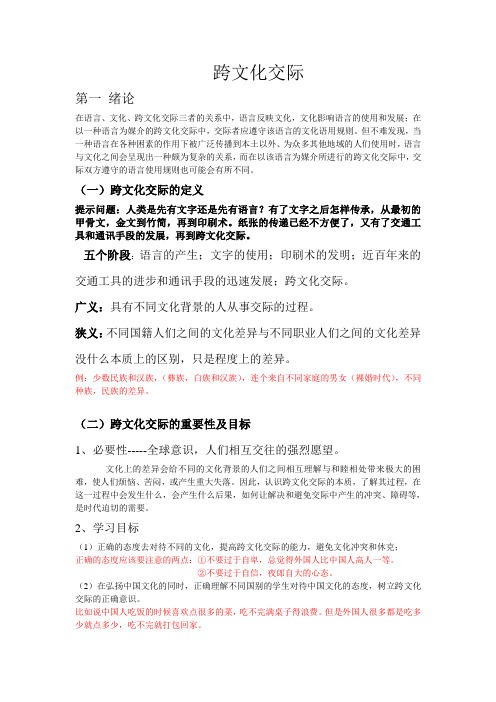
跨文化交际第一绪论在语言、文化、跨文化交际三者的关系中,语言反映文化,文化影响语言的使用和发展;在以一种语言为媒介的跨文化交际中,交际者应遵守该语言的文化语用规则。
但不难发现,当一种语言在各种困素的作用下被广泛传播到本土以外、为众多其他地域的人们使用时,语言与文化之间会呈现出一种颇为复杂的关系,而在以该语言为媒介所进行的跨文化交际中,交际双方遵守的语言使用规则也可能会有所不同。
(一)跨文化交际的定义提示问题:人类是先有文字还是先有语言?有了文字之后怎样传承,从最初的甲骨文,金文到竹简,再到印刷术。
纸张的传递已经不方便了,又有了交通工具和通讯手段的发展,再到跨文化交际。
五个阶段:语言的产生;文字的使用;印刷术的发明;近百年来的交通工具的进步和通讯手段的迅速发展;跨文化交际。
广义:具有不同文化背景的人从事交际的过程。
狭义:不同国籍人们之间的文化差异与不同职业人们之间的文化差异没什么本质上的区别,只是程度上的差异。
例:少数民族和汉族,(彝族,白族和汉族),连个来自不同家庭的男女(裸婚时代),不同种族,民族的差异。
(二)跨文化交际的重要性及目标1、必要性-----全球意识,人们相互交往的强烈愿望。
文化上的差异会给不同的文化背景的人们之间相互理解与和睦相处带来极大的困难,使人们烦恼、苦闷,或产生重大失落。
因此,认识跨文化交际的本质,了解其过程,在这一过程中会发生什么,会产生什么后果,如何让解决和避免交际中产生的冲突、障碍等,是时代迫切的需要。
2、学习目标(1)正确的态度去对待不同的文化,提高跨文化交际的能力,避免文化冲突和休克;正确的态度应该要注意的两点:①不要过于自卑,总觉得外国人比中国人高人一等。
②不要过于自信,夜郎自大的心态。
(2)在弘扬中国文化的同时,正确理解不同国别的学生对待中国文化的态度,树立跨文化交际的正确意识。
比如说中国人吃饭的时候喜欢点很多的菜,吃不完满桌子得浪费。
但是外国人很多都是吃多少就点多少,吃不完就打包回家。
对跨文化交际的理解与认识

对跨文化交际的理解与认识一、引言跨文化交际是指不同文化背景的人之间进行交流和沟通的过程。
在当今全球化的背景下,跨文化交际已经成为一个日益重要的话题。
跨文化交际不仅涉及到个人生活中的各个方面,也是企业、政府和国际组织等机构开展国际合作的重要基础。
本文将从多个角度对跨文化交际进行分析和探讨。
二、跨文化交际的定义1. 跨文化交际的概念跨文化交际是指在不同国家或地区,使用不同语言和符号系统的人之间进行信息传递、意见交流以及价值观念传递等活动。
2. 跨文化交际的特点(1)多元性:涉及到多种语言、多种符号系统、多种价值观念等。
(2)复杂性:涉及到社会制度、政治体制、历史背景等因素。
(3)动态性:随着时代发展和社会变革,跨文化交际也在不断变革。
三、影响跨文化交际的因素1. 语言差异语言是人类最重要的沟通工具之一,但不同语言之间存在差异。
这些差异可能包括语音、语法、词汇、文化背景等方面。
2. 文化差异不同的文化背景会影响人们的价值观念、信仰、习惯和行为方式等方面。
这些差异可能会导致误解和沟通障碍。
3. 社会制度和政治体制社会制度和政治体制也会影响跨文化交际。
例如,在某些国家或地区,政府对媒体进行严格控制,这可能会影响信息传递和意见交流。
4. 历史背景历史背景也是影响跨文化交际的因素之一。
在历史上曾经发生的事件和经历可能会影响人们对某些事物的看法和态度。
四、跨文化交际中需要注意的问题1. 尊重他人文化在跨文化交际中,尊重他人文化是非常重要的。
我们应该了解对方的价值观念、信仰、习惯等,并尽量避免冒犯他人。
2. 学习他人语言学习他人语言可以帮助我们更好地理解对方,并且能够更好地进行沟通和交流。
3. 了解对方文化背景了解对方文化背景可以帮助我们更好地理解对方的行为和思维方式,并且能够更好地进行交流和合作。
4. 避免刻板印象在跨文化交际中,我们应该避免刻板印象,不应该根据个别人或事件来评价整个文化。
5. 注意语言表达方式在跨文化交际中,语言表达方式非常重要。
跨文化交际(全套课件255P)

2021/6/6
第二语言教学的主要目标是培养学生的跨文化交际能力。
• 跨文化交际能力指的是跨文化交际环境中的交际能力,即来自不同文化背景的 人之间进行交际时,具有强烈的跨文化意识,善于识别文化差异和排除文化干 扰并成功地进行交际的能力。是在跨文化交际环境中由语言交际能力、非语言 交际能力、语言规则和交际规则转化能力以及文化适应能力所组成的综合能力。
• 交际双方进行的是实时的口语交际 ,即双方面对面的交谈。 • 交际双方进行的是直接的言语交际。基本上不涉及翻译问题,
而侧重语用规范,通过了解对方文化的价值取向和行为规范 协调双方交际中涉及的文化因素,从而保证交际的有效性。
2021/6/6
第二语言教学与跨文化交际
• 我们的目标不是要将自己的学生培养成外国人,而是将他们培养成沟通中外交 往的桥梁。使他们能够不断转换不同文化的规则和办事方法,帮助桥两头的人 相互适应,成功进行跨越文化的交际。
“夕阳无限好,何愁近黄昏。”
Most glorious is the sunset.Even the dusk is blessde.
“平时不烧香,临时抱佛脚。”
To offer no incense to Buddha when things go well and beseech his help only when in need.
2021/6/6
第二语言教学中需要处理好三种关系
1. 课堂教学与课外交际之间的关系,包括课本语言教学与课外应用指导之间的 关系。
2. 第二语言教学与第二文化教学之间的关系。 3. 培养学生的语言交际能力和培养他们的跨文化交际能力之间的关系。
跨文化交际

跨文化交际
Inter-cultural Communication
跨文化交际是指本族语者与非本族语
者之间的交际, 也指任何在语言和文化背景方 面有差异的人们之间的交际。 通俗来说,就是如果你和外国人打交道, 由于存在语言和文化背景的差异,应该注意什 么问题,应该如何得体地去交流。
从对外汉语专业的角度,“跨文化交际” 的概念可以这样界定:在特定的交际情景 中,具有不同的文化背景的交际者使用同 一种语言(母语或目的语)进行的口语交 际。
交际更注重你的语言表达好与不好,而 交际就意味着用语言进行表 不注重沟通之中对方是否真正理解到了你 所要表达的问题。 达,而在语言表达过程中还有许多
沟通上的问题。 沟通更注重要让对方理解你要表达的意
思,而不是你所说的话。
所以,在某种意义上来说,“跨文 化交际”更倾向于“跨文化沟通”。
Thank you !
2.交际双方必须使用同一种语言交际
交际的双方来自不同的文化背景,又要使用同 一种语言,如果用来交际的语言对一方来说是母 语,对另一方来说必然是第二语言(习得的“目的 语”)。
比如一个中国人与一个美国 人交谈,他们可以选择使用汉 语,也可以选择使用英语,这样 他们就可以用同一种语言直接交 际,而不需要通过翻译这个中间 环节。这样界定的着眼点也是由 对外汉语专业的特点决定的。
1.交际双方必须来自不同的文化背景
· 文化背景的差异既是指不同文化圈之间的差 异,也是指同一文化圈内部文化之间的差异。 · 立足对外汉语,文化差异主要指不同文化圈 之间的差异,尤其是中国和欧美国家的文化差异。 · 中国同亚洲地区国家虽然也有文化差异的一 面,但要顺利的多,因为这些国家与中国同属东方 文化圈,彼此之间在文化取向和交际规范方面有很 多相通的地方。
什么是跨文化交际

什么是跨文化交际?跨文化交际是什么?所谓跨文化交际,即不同文化背景的人走到一起分享思想、感情和信息时所发生的一切。
跨文化交际的英语名是Intercultural munication,早期也称为Cross-cultural munication。
跨文化交际学最先在美国兴起。
美国是个移民国家,文化碰撞时有发生。
来自世界各地的移民都强调并维护自己的文化,因此形成了美国的多元文化格局。
于是跨文化交际引起了美国学者和各界人士的广泛关注。
日本也不甘落后,于1972年在东京率先召开了第一届跨文化交际学国际研讨会,出席人数超过两千。
1974年,跨文化教育训练与研究学会(SIETAR,Society for Intercultural Education,Training and Research)在美国正式宣布成立。
我国研究跨文化交际学起步较晚。
北京外国语大学著名语言学家胡文仲教授于80年代初期开始从事跨文化交际学的研究,著作颇丰,目前已经编著出版了《跨文化交际学概论》跨文化与语言交际》等多部图书。
目前,跨文化交际学已发展成为一门被国际学者们充分重视的集人类学、语言学、心理学、传播学、社会学等为一体的综合性学科。
什么是跨文化交际能力就是拥有能够和你不同文化的人进行正常有效沟通的能力啊。
比如和其他国家的人,或者其他民族的人交流,你们生活的地域不同,文化也不同,风俗习惯不同,思考方式自然也不同。
比如同样的手势,在不同的文化中可能代表截然相反的概念。
这就要求交流者同时了解这两种文化的背景,才能进行有效的沟通。
跨文化交际的内容简介《跨文化交际》是“新编研究生英语系列教材”之一。
本系列教材是外教社组织国内10余所重点高校的专家、教授,在广泛的市场调研和对当前研究生英语教学实际情况进行详细分析的基础上,倾力打造而成,以满足新时期人才培养的需要,和多样化、个性化的学习需求。
跨文化交际的内容简介改革开放以来,中国发生了翻天覆地的变化,国际化”与国际接轨”这样的字眼,已在中国广泛使用。
- 1、下载文档前请自行甄别文档内容的完整性,平台不提供额外的编辑、内容补充、找答案等附加服务。
- 2、"仅部分预览"的文档,不可在线预览部分如存在完整性等问题,可反馈申请退款(可完整预览的文档不适用该条件!)。
- 3、如文档侵犯您的权益,请联系客服反馈,我们会尽快为您处理(人工客服工作时间:9:00-18:30)。
1. 2. 3. Nonverbal Communication Kinesics Space and Distance
1. Nonverbal Communication
1.1 Definitions 1.2 Importance 1.3 Functions
Categories of Distance
• Intimate Distance (0-45cm) - for the closest relation, e.g. a couple • Personal Distance (45-120cm) - friends, old classmates, acquaintance and relatives
2.3 Postures
• With two arms up in the air: arrogance • Standing firmly face-to-face: start to fight • Hands on the waist - direct intrusion into others’ affairs • Shrugging shoulders - indifferent, powerless, having no secret to conceal
Definitions (cont’d)
Nonverbal communication is the interaction that is carried out by our bodies, gestures, and tones of voice, in other words, everything except the actual words.
Direct eye contact • Chinese: avoid • North Americans: appreciate • The British: avoid
Eye Contact (cont’d)
• Looking at the person • Looking sideways
Eye Contact (cont’d)
Personal Territory
Private space and personal space Refers to the space people have for their own activities
Proxemics
• The use of space is directly linked to the value system of culture. • Personal territory can be large or small, depending on place, sex, age, and character. • Hold your ground and not back away.
Facial Expressions (cont’d)
Regardless of culture, these expressions are the same: fear, anger, surprise, contempt, disgust, happiness, and sadness.
2.2 Gestures
Level of Meaning
• Cognitive content - stated messages, what is said openly • Affective content - feelings, attitudes, and behaviors 7% through words, 38% through voice, and 55% through looks and behaviors
Summary
Nonverbal Communication - definition, functions Kinesics - definition, facial expression, gesture, posture Space and Distance - categories of distance, attitudes toward crowding, way of queuing
Duration of eye contact (in US): 2.95 seconds and 1.18 seconds • Shorter: shy, uninterested, absent-minded • Longer: with unusually high interest
3. Space and Distance
Others – The Dog Call Sign
• Curl the index finger and tell someone to come to you. • Acceptable in the UK and US, but rude in many Asian countries * Philippines: used only for dogs * Singapore: death
Categories of Distance (cont’d)
• Social Distance (1.3-3m) - colleagues, business partners, people at social gatherings • Public Distance (beyond 3m) - speaking in public
The “V” sign
• Palm outward: - two, victory, general approval, peace or friend • Palm facing yourself - two, insulting (up yours)
Others – The Stop Sign
The Thumb Upn and European countries - great, approve • Australia and Nigeria - up yours • Some Asian and Islamic countries - rude and offensive
2. Kinesics
Kinesics is the nonverbal behavior related to movement, either of parts of the body, or of the body as a whole, including facial expressions, gestures, postures, eye contact, etc. Kinesics is “body language” .
• The “OK” sign • The thumb up and thumb down sign • The “V” sign • Other signs
The “OK” Sign
• America: agree or everything is ok • Latin America: offensive, similar to showing your middle finger • France: you’re worthless • Turkey: one is homosexual • Australia: zero
The Thumb Down Sign
• Sth is bad or sth you do not approve of. • Sth or someone has failed. • Not used as often as the thumbs up sign. It is a rude and arrogant way to indicate failure.
Facial Expressions (cont’d)
Examples of feelings that can be expressed are: fear, anger, surprise, contempt, disgust, happiness, sadness, concentration, confusion, desire, excitement, frustration, glare, and snarl.
1.2 Importance
Reasons:
• Accounts for much of the meaning we derive from conversations. • Spontaneously reflects the speaker’s subconsciousness. • Always present
Postures (cont’d)
• Follow one’s natural habits so often go unnoticed (subconscious in nature) • May damage your image if you neglect your postures
2.4 Eye Contact
1.1 Definitions
Nonverbal communication is the process by which nonverbal behaviors are used, either singly or in combination with verbal behaviors, in the exchange and interpretation of messages in a given situation or context.
3.1 3.2 Proxemics Attitudes Toward Crowding
3.1 Proxemics
Definition: the study of people’s perception and use of space. Four categories: intimate, personal, social, and public distance.
